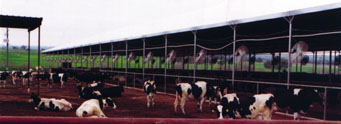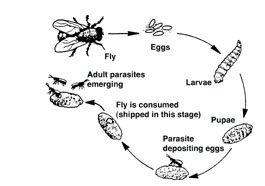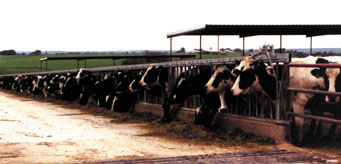|
BUZZ
OFF...
Flies no longer a problem |
||
|
|
||
 No
flies on a dairy farm? Impossible. Maybe once, but today a procedure is
being implemented to control fly populations by using parasites such as
wasp larva. No
flies on a dairy farm? Impossible. Maybe once, but today a procedure is
being implemented to control fly populations by using parasites such as
wasp larva.In the small Central Texas town of Comanche, there is a dairy that is working with a new company to help control its fly problem. Ray and Debbie Johnston are the owners of the Ray Johnston Dairy. They have owned the dairy since 1978. In 1997, they began purchasing the wasp larva from a company in Quemado, Texas. Kunafin Insectary grows, sells and distributes the parasites for fly control throughout the nation. "Once a week, someone brings the larva and implants them into the compost piles and around where cattle are housed. Then the larvae hatch and begin eating the flies," said Debbie Johnston. Once a month, representatives from Kunafin visit the dairy to measure and monitor fly-to-larva ratios. According to Frank Junfin, entomologist and owner of Kunafin, once existing fly population is either eliminated or reduced, the parasite population will also experience a decline because they no longer have the flies to thrive on. In order to enhance fly control, it is important to continue periodic releases of the fly parasites (wasp larva), because fly migration will rapidly cause another buildup. Why then, does a dairy not have a wasp problem? A parasitic wasp’s single ambition is to reproduce. Since wasps are dependent on  fly pupae for reproduction, it it is essential that a balance be maintained
between wasp and fly populations. Therefore, spraying for control of other
insects must be done in a manner such that the wasp larvae are not destroyed.
Dairy producers must be cautious as not to over spray and cause an overpopulation
of wasp. Keeping the population of other insects to a controllable level
insures a manageable ecosystem.
fly pupae for reproduction, it it is essential that a balance be maintained
between wasp and fly populations. Therefore, spraying for control of other
insects must be done in a manner such that the wasp larvae are not destroyed.
Dairy producers must be cautious as not to over spray and cause an overpopulation
of wasp. Keeping the population of other insects to a controllable level
insures a manageable ecosystem. When a wasp finds a fly pupa, it uses its stinger to break a hole in the puparium. The pupa dies once it is exposed to air. The wasp takes a meal from the pupa and lays an egg inside which eventually hatches and feeds on immature flies. The wasp eats only during its 16 to 28 days as an adult. "It is important to realize that no method of insect control is 100 percent effective, including the use of the most powerful insecticides," says Junfin. Costs of fly parasite programs will vary with each operation. Ray Johnston Dairy pays what equals about 30 to 40 cents per head for annual fly control, all of which are performed by Kunafin. Junfin says that annual costs can vary from as low as 20 cents per head to as much as one dollar per head for smaller feeding operations.  A
USDA study showed that calves gained less weight when they contended with
fly issues. Test calves gained about .2 pounds per day less when annoyed
by 50 stable flies. When the number of flies doubled, weight gain was reduced
by about .48 pounds per day. Stepping up control measures can reduce the
incidence of fly-transmitted ailments, such as pink eye,according to the
USDA. A
USDA study showed that calves gained less weight when they contended with
fly issues. Test calves gained about .2 pounds per day less when annoyed
by 50 stable flies. When the number of flies doubled, weight gain was reduced
by about .48 pounds per day. Stepping up control measures can reduce the
incidence of fly-transmitted ailments, such as pink eye,according to the
USDA.This parasite control is not just for dairies, Kunafin also sells their parasites to cattle feeders, ranches and farms to control fly populations. If you would like more information on biological fly control or would like to speak with a representative, contact Kunafin at 1-800-832-1113 or www.kunafin.com. |
||